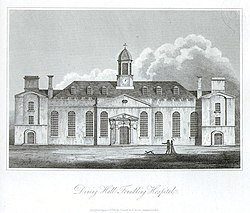Hospital in Dublin, Republic of Ireland
| Foundling Hospital, Dublin | |
|---|---|
 "Dining Hall, Foundling Hospital", Dublin. "Dining Hall, Foundling Hospital", Dublin. | |
 | |
| Geography | |
| Location | Dublin, Republic of Ireland |
| Coordinates | 53°20′31″N 6°17′45″W / 53.3420°N 6.2958°W / 53.3420; -6.2958 |
| History | |
| Opened | 1704 |
| Closed | 1835 |
| Dublin Foundling Hospital Act 1798 | |
|---|---|
| Act of Parliament | |
 Parliament of Ireland Parliament of Ireland | |
| Long title | An Act to authorise the issuing and payment of the sum of £5,000, granted as a further supply for the foundling hospital and workhouse in the city of Dublin. |
| Citation | 38 Geo. 3. c. 64 (I) |
| Territorial extent | Ireland |
| Dates | |
| Royal assent | 6 October 1798 |
| Commencement | 6 October 1798 |
| Repealed | 3 July 1879 |
| Other legislation | |
| Repealed by | Statute Law Revision (Ireland) Act 1879 |
| Status: Repealed | |
The Foundling Hospital was a hospital for abandoned children in Dublin, Ireland which was established as part of the South Dublin Union.
History

The Foundling Hospital of Dublin was opened in 1704 and was likely designed by Thomas Burgh. The front doorcase was in the manner of Michelangelo's Porta Pia in Rome. Between 1798 and 1804, Francis Johnston was involved in designing new structures on the site including a chapel and infirmary as well as embellishing the front with a castellated parapet and cupola.
Firmly established by the mid-18th century, the Foundling Hospital had steadily become a large "baby farming" institution. Two primary objectives of the hospital were to avoid deaths and murders of illegitimate children and to teach the Protestant faith to these children.
No inquiry was made about the parents, and no money was received. A cradle was installed by 1730. Between 1,500 and 2,000 children were received annually. A large income was derived from a duty on coal. In 1822 an admission fee of £5 was charged on the parish from which the child came. This reduced the annual arrivals to about 500.
Child deaths during transport to the hospital or whilst staying in the hospital were not infrequent and would often become the subject of an inquiry. The number of Protestant nurses was usually inadequate with the resulting use of Roman Catholic nurses and occasional consequence of "religious error".
Between 1790 and 1796 some 5,216 infants were sent there, of whom 5,215 died. Between 1796 and 1826 51,150 infants were admitted to the hospital, of whom 41,524 died. In 1829 the select committee on the Irish miscellaneous estimates recommended that no further assistance should be given. Only during the tenure of Lady Arabella Denny and later the other “Ladies Governesses” did the death rate and horrific conditions of the foundling hospital improve. However during its existence the hospital had not preserved life or educated the foundlings. The mortality was nearly 4 in 5, and the total cost climbed to almost £40,000 a year. Accordingly, in 1835 Lord Glenelg (then Irish Secretary) closed the institution.
The hospital was only demolished in the second half of the 20th century to be replaced with buildings within the St James's Hospital campus.
New National Children's Hospital
A new children's hospital has been proposed to move the National Children's Hospital from Tallaght University Hospital onto the campus of St. James's Hospital.
Former senator, John Gilroy, said that given the presence of the foundling hospital on the site and the very high death rate, there was a possibility that children might have been buried there. However extensive investigation including the environmental impact study and the site excavation works found no evidence of any graves on the site.
See also
References
- ^ Chisholm, Hugh, ed. (1911). "Foundling Hospitals" . Encyclopædia Britannica. Vol. 10 (11th ed.). Cambridge University Press. pp. 746–747.
- Fürst, Ulrich (1998). The Architecture of Rome An Architectural History in 400 Individual Presentations. Axel Menges. p. 159. ISBN 978-3930698608.
- McParland, Edward (2001). "Public Architecture in Ireland, 1680-1760". Paul Mellon Centre for Studies in British Art. Retrieved 19 November 2024.
- "Dictionary of Irish Architects". www.dia.ie. Retrieved 19 November 2024.
- ^ Wodsworth, William Dudley, ed. (1876). A Brief History of the Ancient Foundling Hospital of Dublin, From the Year 1702. With some account of similar institutions abroad. Dublin: Alexander Thom. pp. 1–2.
- Powell, Fred (1981). "Dean Swift and the Dublin Foundling Hospital". Studies: An Irish Quarterly Review. 70 (278/279): 162–170. JSTOR 30090351. PMID 11636080.
- Sonnelitter, Karen (2016). Charity Movements in Eighteenth-Century Ireland: Philanthropy and Improvement. Woodbridge: Boydell & Brewer. p. 152. ISBN 978-1-78327-068-2.
- Wodsworth, p. 11.
- "Accounts and Papers". 1833. Retrieved 14 November 2019.
- Wodsworth, p. 52.
- Morgan, Alexander Campbell (1956). "[St. James's Hospital, James's Street, Co. Dublin]". catalogue.nli.ie. Retrieved 19 November 2024.
- ^ O’Riordan, Sean (9 August 2021). "Thousands of infants could be buried in mass graves on National Children's Hospital grounds". Irish Examiner. Retrieved 10 August 2021.
- Hilliard, Mark. "No human remains found on site of new children's hospital – developers". The Irish Times.
- Moloney, Eoghan (9 August 2021). "National Children's Hospital dismisses claims children's graves could be located on site". independent.